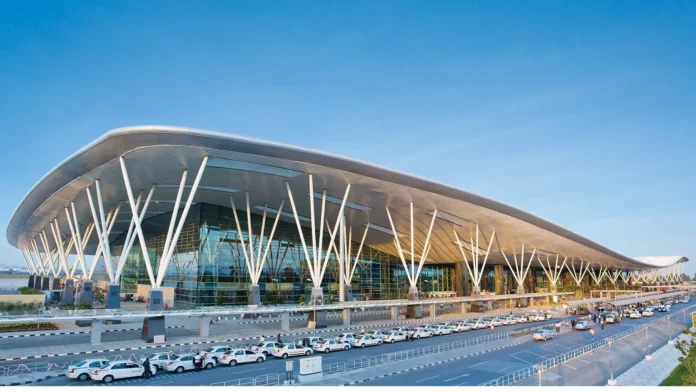India’s busiest airports connect the country to the world and serve as key domestic travel hubs. We’ll explore the top 10 busiest Indian airports, their importance, and passenger numbers. The table below shows these airports and their yearly changes in passenger traffic.
Busiest airports in India list consist of the top 15 commercial airports with the highest passenger traffic as of 2023-24. The Airports Authority of India (AAI) releases data that ranks these airports based on specific criteria.
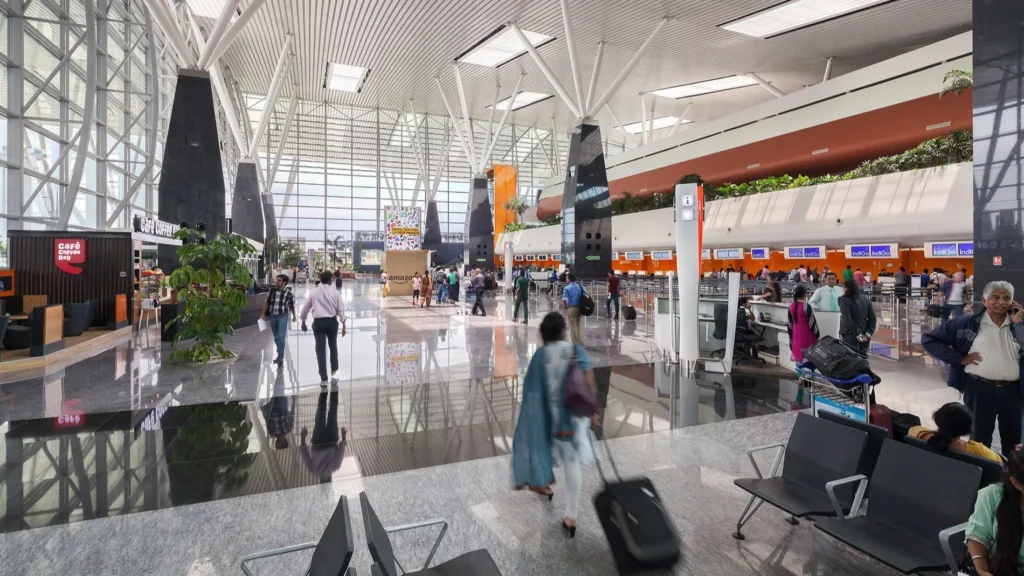
Top 15 Busiest Airports in India
| Rank | Airport Name | City | March 2024 | 2023-24 Traffic | 2022-23 Traffic | Change % |
|---|---|---|---|---|---|---|
| 1 | Indira Gandhi International Airport | Delhi | 66,28,532 | 7,36,73,708 | 6,53,27,833 | 12.8% |
| 2 | Chhatrapati Shivaji Maharaj International Airport | Mumbai | 45,03,829 | 5,28,20,754 | 4,39,30,298 | 20.2% |
| 3 | Kempegowda International Airport | Bangalore | 32,28,069 | 3,75,28,533 | 3,19,11,429 | 17.6% |
| 4 | Rajiv Gandhi International Airport | Hyderabad | 22,16,157 | 2,50,42,282 | 2,09,96,027 | 19.3% |
| 5 | Chennai International Airport | Chennai | 17,81,706 | 2,12,07,262 | 1,85,71,393 | 14.2% |
| 6 | Netaji Subhash Chandra Bose International Airport | Kolkata | 17,56,620 | 1,97,84,417 | 1,77,68,862 | 11.3% |
| 7 | Sardar Vallabhbhai Patel International Airport | Ahmedabad | 10,31,004 | 1,16,96,227 | 1,01,37,001 | 15.4% |
| 8 | Cochin International Airport | Kochi | 8,31,939 | 1,03,65,655 | 88,12,531 | 17.6% |
| 9 | Pune International Airport | Pune | 8,27,727 | 95,25,484 | 80,07,160 | 19.0% |
| 10 | Dabolim International Airport | Goa | 5,90,852 | 68,72,411 | 83,59,393 | -17.8% |
| 11 | Chaudhary Charan Singh International Airport | Lucknow | 5,44,615 | 61,84,850 | 52,20,528 | 18.5% |
| 12 | Lokpriya Gopinath Bordoloi International Airport | Guwahati | 5,20,275 | 59,57,609 | 50,51,480 | 17.9% |
| 13 | Jaipur International Airport | Jaipur | 4,96,703 | 54,66,552 | 47,64,382 | 14.7% |
| 14 | Biju Patnaik International Airport | Bhubaneswar | 3,98,385 | 46,00,615 | 36,24,905 | 26.9% |
| 15 | Manohar International Airport | Goa | 4,27,427 | 44,06,087 | 6,64,160 | 563.4% |
Note: The traffic numbers are in absolute passenger count. The “Change %” column shows the percentage change from 2022-23 to 2023-24. You will be surprised to see some airports at higher positions, especially Goa if we combine both airports it ranks at 8th position.
Table of contents
- Top 15 Busiest Airports in India
- 1) Indira Gandhi International Airport (DEL)
- 2) Chhatrapati Shivaji Maharaj International Airport (BOM)
- 3) Kempegowda International Airport (BLR)
- 4) Rajiv Gandhi International Airport (HYD)
- 5) Chennai International Airport (MAA)
- 6) Netaji Subhash Chandra Bose International Airport (CCU)
- 7) Sardar Vallabhbhai Patel International Airport (AMD)
- 8) Cochin International Airport (COK)
- 9) Pune International Airport (PNQ)
- 10) Dabolim International Airport (GOI)
- 11) Chaudhary Charan Singh International Airport (LKO)
- 12) Lokpriya Gopinath Bordoloi International Airport (GAU)
- 13) Jaipur International Airport (JAI)
- 14) Biju Patnaik International Airport (BBI)
- 15) Manohar International Airport (GOX)
1) Indira Gandhi International Airport (DEL)
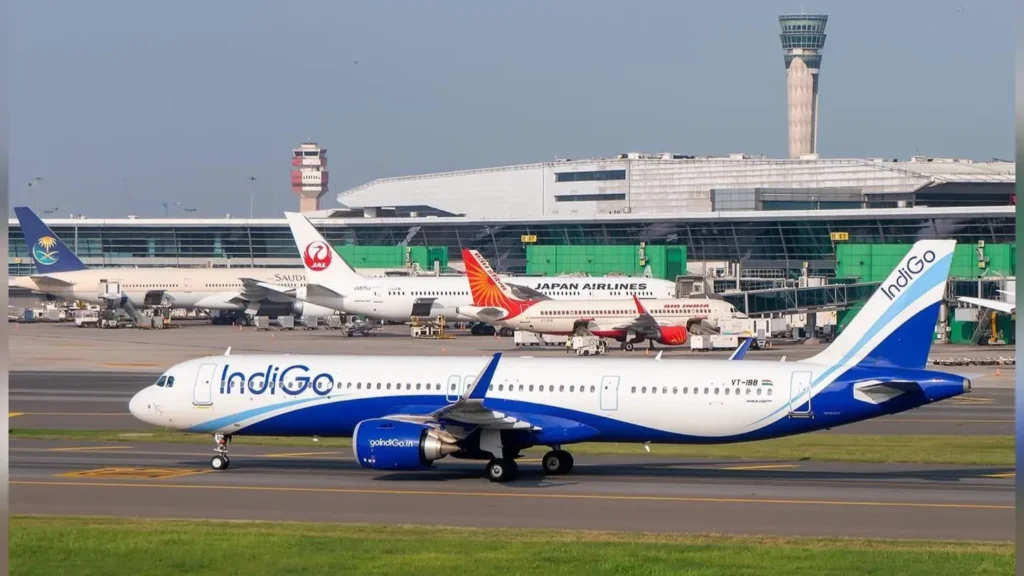
Palam Airport, renamed Indira Gandhi International Airport in 1986, expanded from a 3 million passenger capacity in 1979-80 to meet growing demand. Terminal 2 opened in 1986, while Terminal 1 was divided into blocks for domestic and international operations.
Recent renovations include a new domestic arrivals terminal and departures block. The airport now serves as a hub for major Indian carriers such as Air India (AI) and IndiGo (6E), hosting about 80 airlines across three active passenger terminals and a cargo terminal. IGI Airport is the busiest airport in India and the 9th Busiest Airport in the world in 2024.
IGI Airport is Owned by GMR Airport Limited (64%), AAI (26%), and Fraport AG Frankfurt Airport Services Worldwide (10%).
- Passenger Traffic: 73,673,708
- No. of Terminals: 3
- Area: 21.6 Sq. km
2) Chhatrapati Shivaji Maharaj International Airport (BOM)
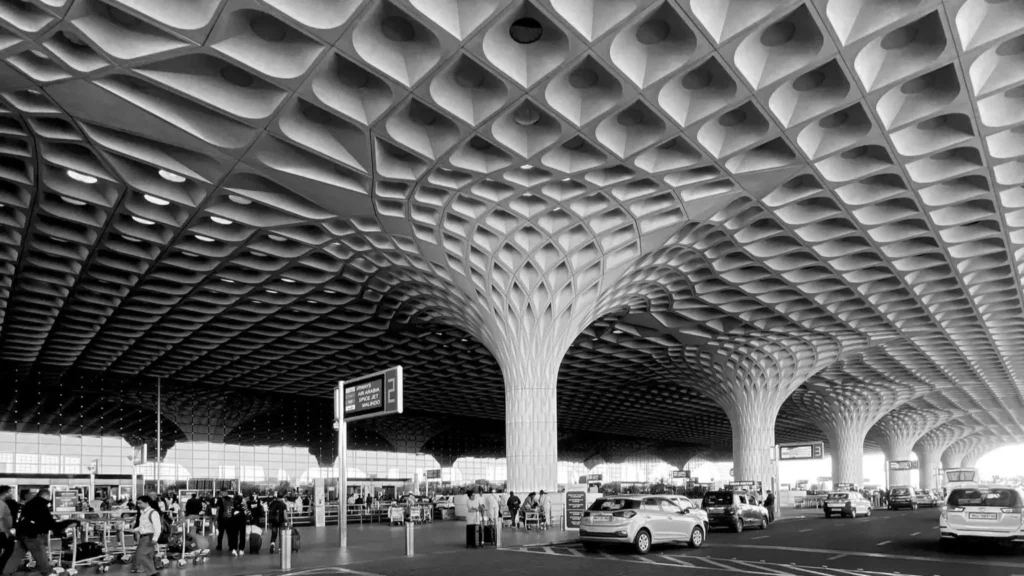
Mumbai Airport initially as RAF Santacruz was built in the 1930s. It became a major airfield during World War II. In 1946, it transitioned to civil operations with converted hangars serving as terminals.
Traffic increased after India’s partition, prompting government development. A new terminal opened in 1958 under the Ministry of Civil Aviation (MoCA). In 2006, a private consortium formed MIAL to manage the airport, implementing significant improvements.
MIAL introduced technological advancements, making it India’s first airport with self-service kiosks and CUTE systems. In 2021, the Adani Group acquired GVK and Bidvest. It is 2nd most busiest airport in India.
Adani Group has a 74% stake in MIAL along with a 26% stake in AAI.
- Passenger Traffic: 52,820,754
- No. of Terminals: 2
- Area: 5.9 Sq. km
3) Kempegowda International Airport (BLR)
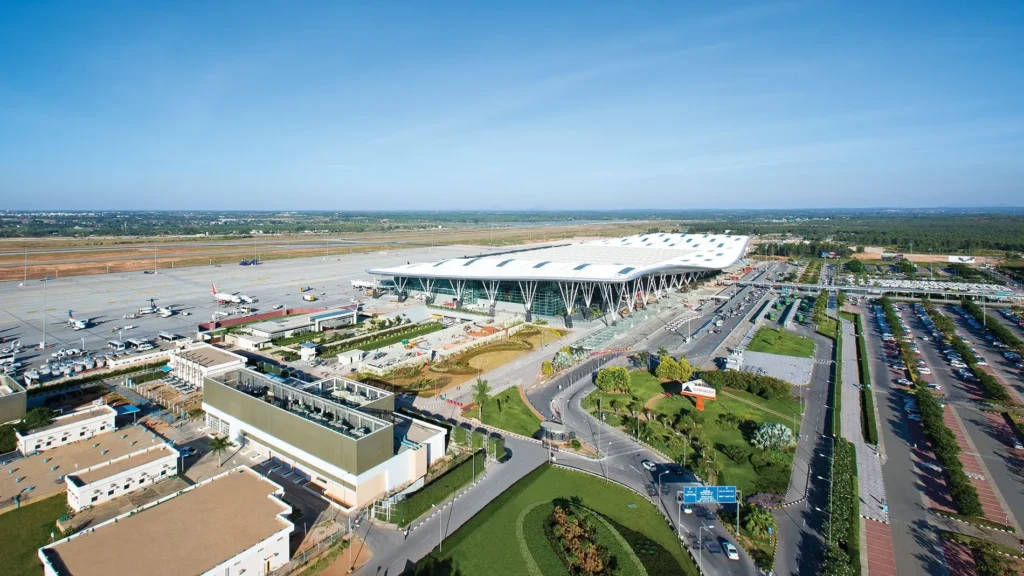
HAL Airport, Bengaluru was established in 1942. It began its domestic operations in the late 1970s and international operations in the 1990s. As passenger traffic grew, HAL Airport’s limitations led to the need for a new airport.
In 1991, Devanahalli was selected as the site for a new airport, with construction approved in 1994. After initial setbacks, Bengaluru International Airport Limited (BIAL) was formed to build and operate the new airport.
BIAL is a formed under public-private partnership. Fairfax Financial (54%), Siemens Project Ventures (20%), and AAI (26%) are the companies that hold a stake in the BIAL. The Airports Authority of India plans to sell a 13% stake to raise funds for the Airport.
The Kempegowda International Airport (BLR) airport is also planning a third terminal which will be completed by 2030. It will allow BLR to handle 90-100 million passengers annually.
- Passenger Traffic: 37,528,533
- No. of Terminals: 2
- Area: 16.2 Sq. km
4) Rajiv Gandhi International Airport (HYD)

Hyderabad’s Begumpet Airport’s capacity limitations led to the search for a new airport site. After considering multiple locations, Shamshabad was chosen in 1998 due to its strategic position near highways and railways.
In 2000, a public-private partnership was established for the new airport project, with 26% stake held by the government and 74% by private companies.
GMR Group and Malaysia Airports Holdings Berhad won the bid for the private stake. The airport is now owned and operated by GMR Hyderabad International Airport Ltd (GHIAL).
The concession agreement allows GHIAL to operate the airport until 2068. In 2024, GMR Group acquired Malaysia Airports Holdings Berhad’s 11% stake, increasing its total ownership to 74%.
- Passenger Traffic: 25,042,282
- No. of Terminals: 1
- Area: 22.2 Sq. km
5) Chennai International Airport (MAA)

Chennai’s aviation history began in 1910 with Giacomo D’Angelis’ biplane flight, marking Asia’s first powered flight. Civil aviation started in 1915 with Tata Air Mail.
Madras aerodrome, commissioned in 1930, was one of India’s first airports. J.R.D. Tata landed the first scheduled flight in 1932. Initially used for military operations during World War II, the Civil Aviation Department took over in 1952.
The first passenger terminal was built in 1954. The Airports Authority of India assumed control in 1972. An air cargo complex opened in 1978. In 1985, passenger operations moved to a new domestic terminal in Tirusulam, with an international terminal added in 1989.
Chennai Airport is owned and operated by AAI. It also serves as the regional headquarters for southern India. Recently, there have been talks that AAI might privatize the airport.
- Passenger Traffic: 21,207,262
- No. of Terminals: 3
- Area: 5.2 Sq. km
6) Netaji Subhash Chandra Bose International Airport (CCU)
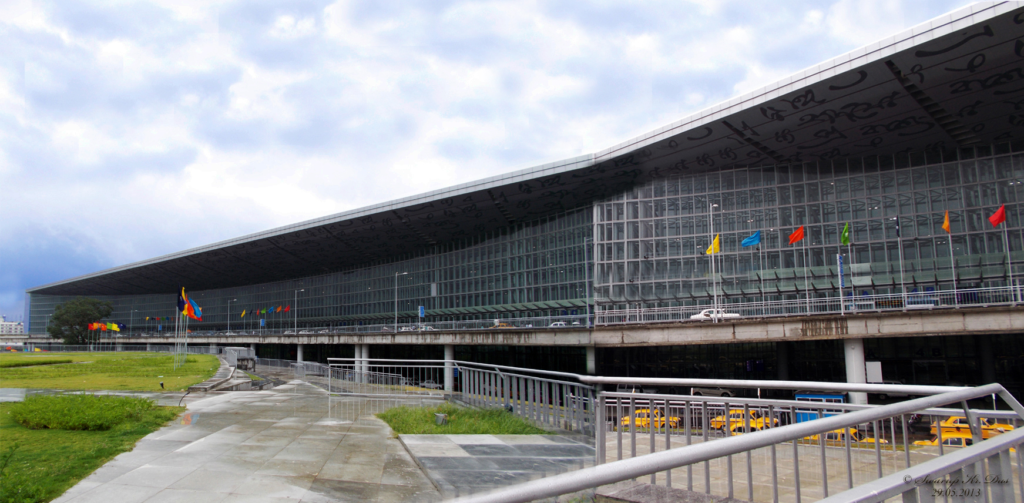
Netaji Subhas Chandra Bose International Airport, originally Calcutta Aerodrome, was established in the early 1900s. It served as a strategic stopover on international routes. KLM (KL) began scheduled stops in 1924, the same year an RAF aircraft landed during the first round-the-world air expedition.
The airport started as an open ground near the Royal Artillery Armoury in Dum Dum. Bengal Flying Club opened there in 1929. By 1930, it became a year-round airfield, attracting various airlines. Notable flights, including Amelia Earhart’s in 1937, passed through.
In 2005, the rise of low-cost carriers led to a significant increase in passenger numbers, necessitating a comprehensive modernization plan due to terminal overcrowding. The Airport Authority of India owns and operates this airport.
- Passenger Traffic: 19,784,417
- No. of Terminals: 2
- Area: 6.7 Sq. km
7) Sardar Vallabhbhai Patel International Airport (AMD)

Ahmedabad Airport, established in 1937, began international operations in 1991 and was officially categorized as an International airport in 2000. Air India operated flights to London (2004-2008, 2016-2018) and Frankfurt (2009-2010).
The new Terminal 2 for international passengers opened in 2010, featuring a statue of Sardar Vallabhbhai Patel. In 2017, a 700 kWp rooftop solar plant was commissioned.
The airport is owned by the Airport Authority of India (AAI) but operated by the Adani Group, reflecting a public-private partnership (PPP) model in Indian aviation infrastructure.
- Passenger Traffic: 11,696,227
- No. of Terminals: 2
- Area: 4.4 Sq. km
8) Cochin International Airport (COK)

Kochi’s airport originated as a 1936 airstrip on Willingdon Island, built by the Kingdom of Cochin. During World War II, it became a British military airport and Indian Navy headquarters.
Post-independence, the Indian Navy operated it while allowing civilian use. The 1980s Gulf economic boom necessitated international connections.
Cochin International Airport, India’s first public-private partnership airport, was established in 1994. It’s owned by Cochin International Airport Limited (CIAL), with the Kerala Government holding 33.36%. Other stakeholders include Indian government companies (8.74%), foreign companies (5.42%), Indian companies (8.57%), banks (5.91%), and over 10,000 personal investors (38.03%), mostly non-resident Indians from 29 countries.
- Passenger Traffic: 10,365,655
- No. of Terminals: 3
- Area: 6.8 Sq. km
9) Pune International Airport (PNQ)
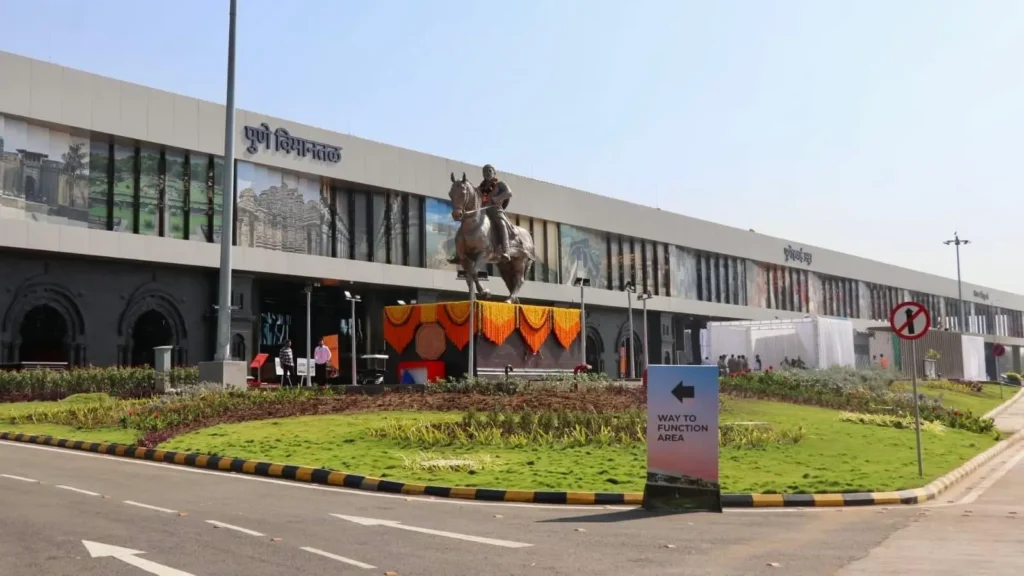
Pune International Airport, established in 1939 as RAF Pune, initially provided air security for Mumbai. It hosted World War II squadrons before transferring to the Royal Indian Air Force in 1947.
International flights began in 2005 with routes to Dubai and Singapore. Passenger traffic grew significantly from 60,000 in 2004-05 to 2.8 million in 2010-11. Lufthansa (LH) initiated the Frankfurt-Pune service in 2008, using PrivatAir’s modified Airbus A319 due to runway constraints.
A ₹100 crore modernization plan, launched for the Commonwealth Youth Games, expanded the terminal by 24,000 m² in 2008. It is now the 9th busiest airport in India.
Pune International Airport is owned by the Indian Airforce and Operated by the Airport Authority of India (AAI).
- Passenger Traffic: 9,525,484
- No. of Terminals: 1
- Area: 1.6 Sq. km
10) Dabolim International Airport (GOI)
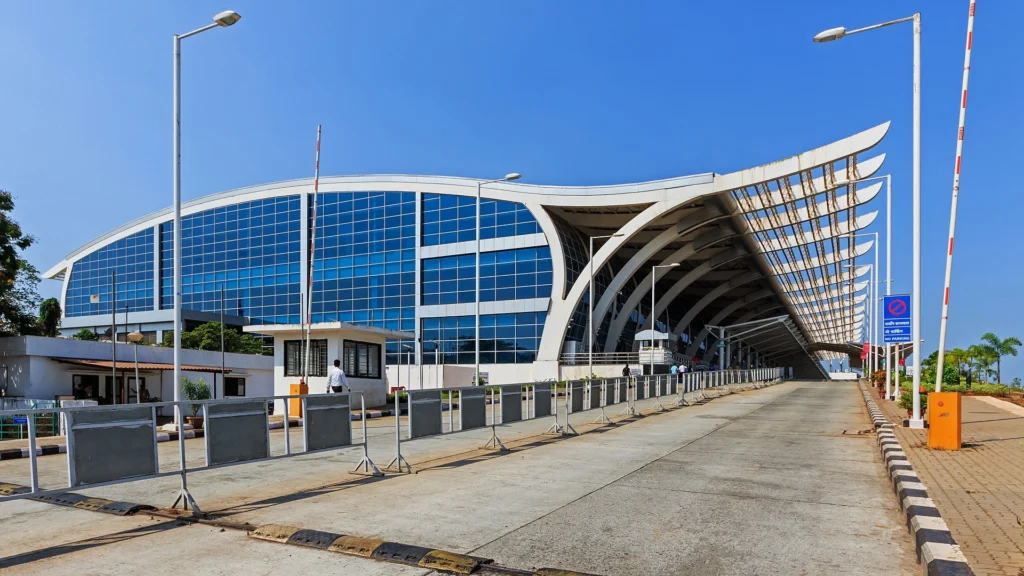
Dabolim Airport, established in 1955 by Portuguese India, initially served as TAIP’s main hub. During Goa’s annexation in 1961, it was bombed by the Indian Air Force. The Indian Navy took control in 1962, allowing civilian operations from 1966.
New domestic and international terminals were built in 1983 and 1996, respectively. Charter flights boomed in the 1980s after infrastructure improvements and Goa hosting CHOGM.
In 2006, the Indian government announced an upgrade plan, including a new international terminal and expanded aircraft stands. However, land transfer delays from the Navy hindered the project’s completion.
Dabolim Airport is currently owned by Govt. of Goa and the Indian Navy. It is Operated by the Airport Authority of India.
- Passenger Traffic: 6,872,411
- No. of Terminals: 1
- Area: 6.88 Sq. km
11) Chaudhary Charan Singh International Airport (LKO)

Chaudhary Charan Singh International Airport in Lucknow, established in 1986, was upgraded in 1996 due to increasing demand. It was renamed in 2008, and it expanded with Terminal 2 in 2012, gaining international status.
In 2018, construction of Terminal 3 began, costing ₹2,400 crore. Delayed by the COVID-19 pandemic, it was inaugurated on March 10, 2024, by Prime Minister Modi. The new terminal spans 111,367 m², features seven aerobridges, and can handle 13 million passengers annually.
It’s designed to reflect local culture while matching Frankfurt Airport’s modern amenities. An elevated road connects it to NH-27. Future plans include expanding Terminal 3 eastward by demolishing Terminal 1.
Chaudhary Charan Singh International Airport is owned by the Airport Authority of India and operated by the Adani Group.
- Passenger Traffic: 6,184,850
- No. of Terminals: 2
- Area: 5.3 Sq. km
12) Lokpriya Gopinath Bordoloi International Airport (GAU)
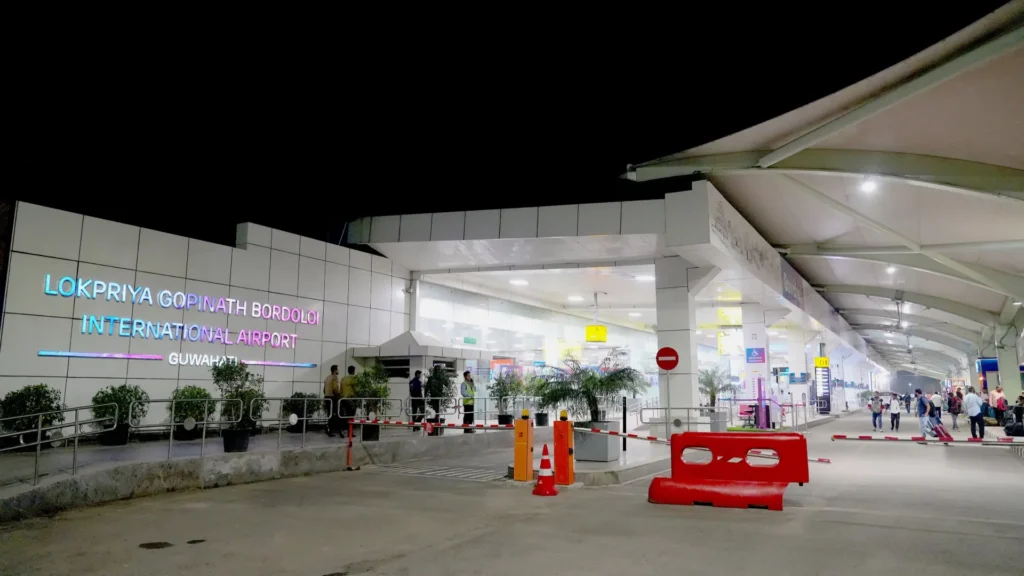
Lokpriya Gopinath Bordoloi International Airport in Guwahati, established in 1958, has undergone multiple expansions to support regional development. Passenger traffic grew from 3.7 million in 2017 to 5.7 million in 2018-19, with 55,066 aircraft movements.
In 2023, it nearly reached its 6 million annual passenger capacity. The airport briefly operated international flights to Bangkok in 2002. In 2019 and 2021, it won bids for international routes under the UDAN Scheme, including Dhaka, Bangkok, Kuala Lumpur, Singapore, and Yangon.
In February 2019, Adani Group acquired a 50-year lease for ₹160 per passenger. The Airport is owned by the Airport Authority of India (AAI).
- Passenger Traffic: 5,957,609
- No. of Terminals: 1
- Area: 5.9 Sq. km
13) Jaipur International Airport (JAI)
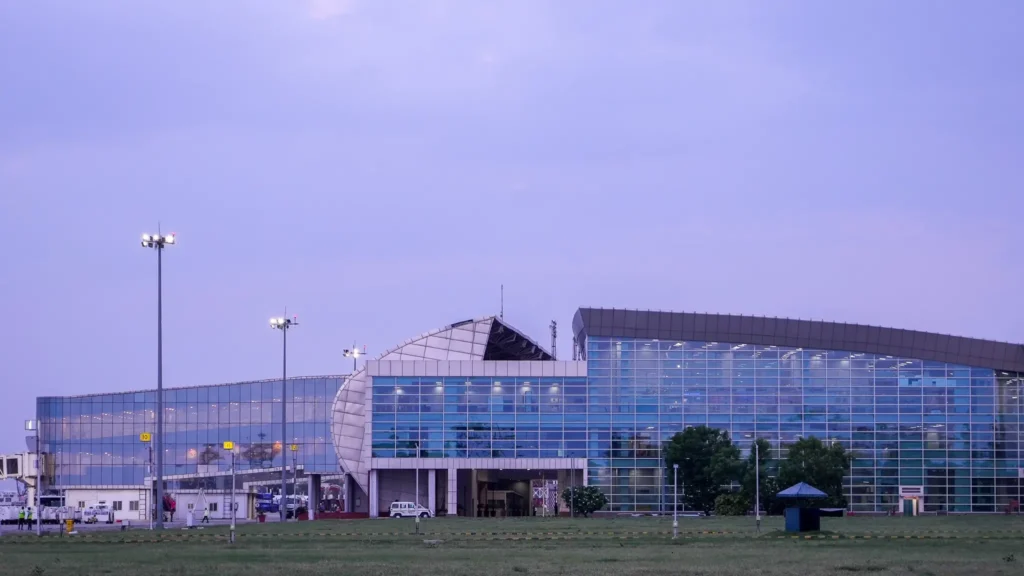
Jaipur International Airport received international status in 2005. It accommodates 14 aircraft, and the integrated terminal handles 1,000 peak-hour passengers.
The domestic terminal, inaugurated in 2009, spans 22,950 square meters with modern facilities. Terminal 1, formerly for international flights, now serves cargo operations. Terminal 2 took over international flights in July 2012.
Current expansion plans include widening Terminal 2 on each side, adding a new departure hall, three conveyor belts, and two aerobridges. A future integrated third terminal, seven times larger than Terminal 2, will replace passenger operations at Terminals 1 and 2.
The Jaipur International Airport is owned by the Airport Authority of India and operated by the Adani Group.
- Passenger Traffic: 5,466,552
- No. of Terminals: 2
- Area: 2.9 Sq.km
14) Biju Patnaik International Airport (BBI)
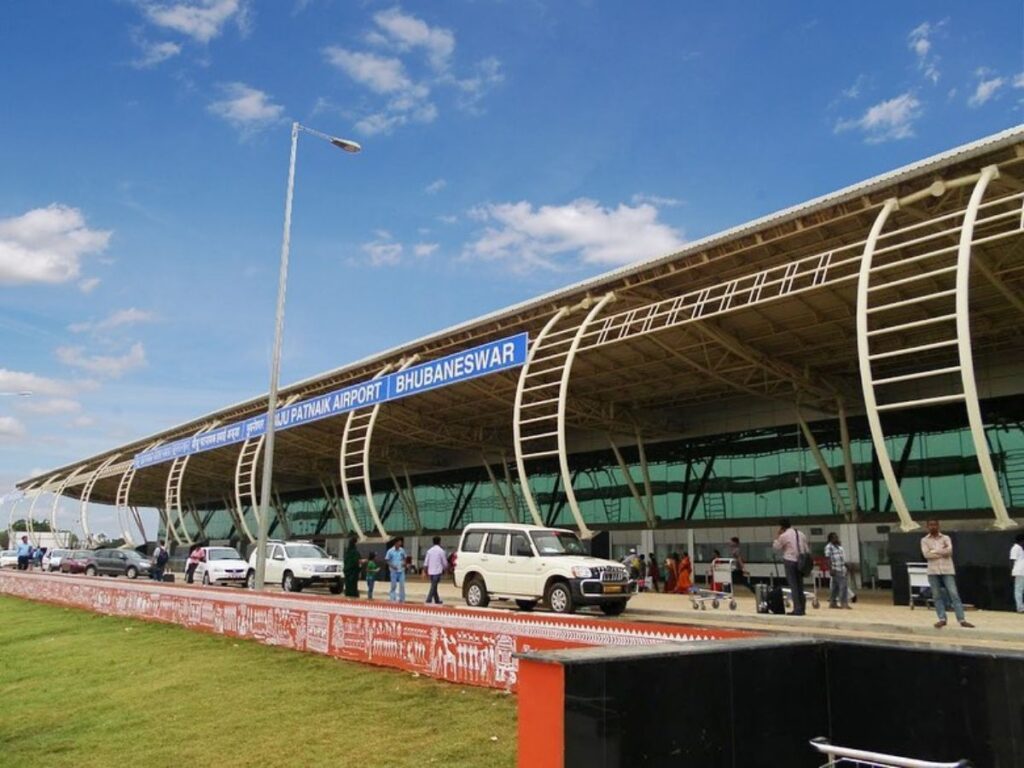
Biju Patnaik International Airport in Bhubaneshwar is Odisha’s first commercial airport, opened in 1962. It has two terminals: Terminal 1 for domestic and Terminal 2 for international flights.
Terminal 1 was inaugurated in 2013 and cost ₹1.45 billion and can handle 4 million passengers annually. It features 4 aerobridges, 18 check-in counters, and various amenities.
Terminal 2 was built in the 1960s and was repurposed for international operations in 2013. The airport gained international status in October 2013. After a COVID-19 interruption, international flights resumed in May 2023 with routes to Bangkok, Dubai, and Singapore. In May 2023, a 4 MW solar plant made the airport fully sustainable. AirAsia resumed Kuala Lumpur flights in May 2024.
Biju Patnaik International Airport is owned and operated by the Airport Authority of India (AAI).
- Passenger Traffic: 46,00,615
- No. of Terminals: 2
- Area: The terminal area is 18.24 sq. km, the overall airport size isn’t explicitly stated.
15) Manohar International Airport (GOX)
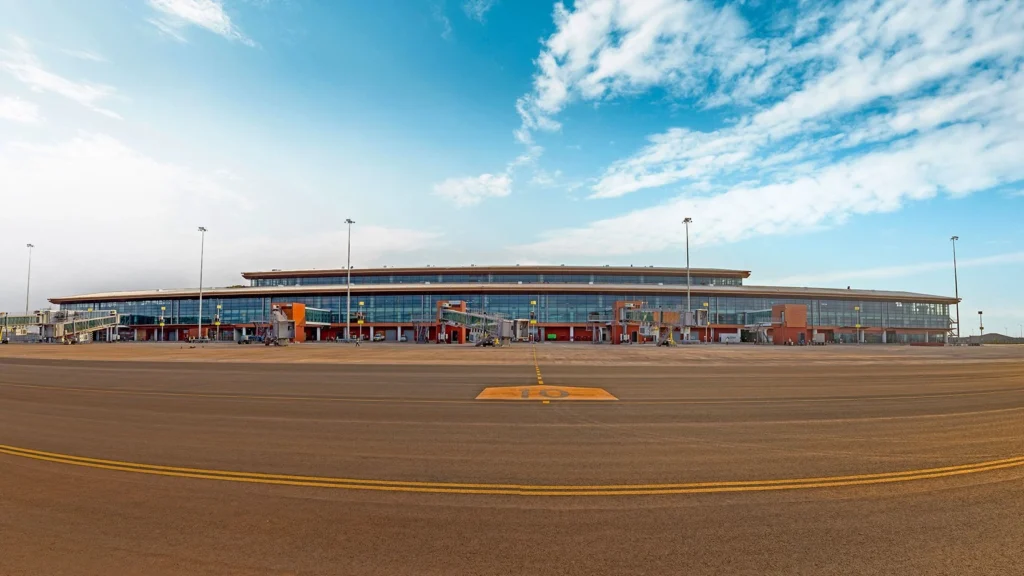
Manohar International Airport, Goa’s second airport, opened on January 5, 2023. Developed by GMR Goa International Airport Limited at a cost of ₹3,000 crore, it handled over 4.4 million passengers in FY 2023-24, nearing its 4.5 million capacity.
The project, initially proposed in 2000, faced delays due to land acquisition issues and the COVID-19 pandemic. It addresses the limitations of Dabolim Airport, a civil enclave at a military airfield.
The new airport is the 15th busiest airport in India, handling about 100 aircraft movements and 15,000 passengers daily. An Aviation Skill Development Centre on the airport premises aims to provide employment opportunities for local youth. The airport is named after former Goa Chief Minister Manohar Parrikar.
Manohar International Airport is owned and operated by GMR Airports Limited.
- Passenger Traffic: 4,406,087
- No. of Terminals: 1
- Area: 8.6 Sq. km
This concludes our top 15 airports list, let us know your favorite airport in the comments on our social media posts.
Join our Telegram Group for the Latest Aviation Updates. Subsequently, follow us on Google News.
The post Top 15 Busiest Airports in India of 2024 appeared first on Aviation A2Z.

